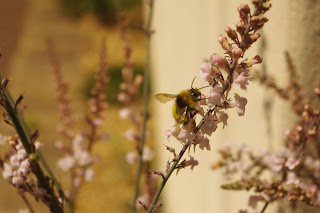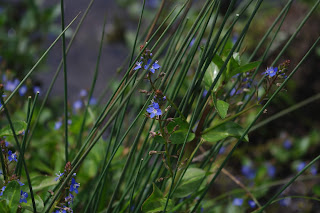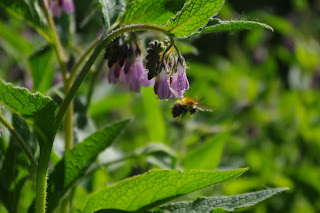A diary of back garden botany, urban ecology, rural rambles and field trips to the middle of nowhere...
Sunday, 31 May 2020
Ribwort Plantain (Plantago lanceolata), a perennial of grasslands and disturbed ground. In fact I notice that its niche in the garden and on the allotment is where the cultivated bed meets the edge of the grass. Its presence in fossil pollen records of the Neolithic Period suggests that it is an indicator plant of the spread and development of agriculture. Frequently described as a weed but I shall not dignify that assertion with a response.
NB The longer spikes look more like Greater Plantain (Plantago major) which grows in similar spots. Will have to look more closely next time I'm out- are both growing alongside each other?
Postscript 1/06/20 Ok, I'm confused. Ribwort Plantain has narrow spear shaped leaves and compact flower heads. Greater Plantain has oval shaped leaves and long flower spikes. This Plantain has spear shaped leaves but long flower spikes. Will the real Plantain please stand up?
Friday, 29 May 2020
Linaria purpurea pops up all over the place at this time of year, a plant of southern Italy that self-seeds readily and is widely naturalised in the UK. Most commonly the flowers are indeed purple and accordingly it goes by the name of Purple Toadflax.
There is also a less common form with pale pink flowers known as L. purpurea Canon Went. Purple Toadflax is a bee magnet and it looks like the same can be said of the pink variety.
Thursday, 28 May 2020
I happened to see both our native Irises in flower today: Stinking Iris (Iris foetidissima) and Yellow Flag Iris (Iris pseudacourus).
I. foetidissima grows in the deepest shade, even dry shade; actually it will grow anywhere. It is noted for clusters of bright red berries in autumn that last right through winter. If you read up on the species the small pale lilac flowers are regularly referred to with epithets like "dull" and "inconspicuous". That seems unduly harsh, I would suggest subtle and exquisite might be better terms to use.
Moreover the clumps I saw today appear to be I. foetidissima var. citrina. The flowers have a lovely lemony hue as well as the delicate purple veining. Really very charming for a plant that is as tough as the toughest pair of old boots. A bumblebee was making its way around them but I didn't unshoulder my camera quick enough for a pic.
Later however I saw I. pseudacorus growing en masse alongside a stretch of country lane. Yellow Flag can cope with a bit of shade but is basically a sun lover that inhabits the margins of flowing water, ponds, bogs etc. The stand I came across today was surrounded by dry, chalky fields but flourishing in a muddy sump fed by ditches.
Bumblebees were buzzing all over them. In the photograph above for example you can see one bumbler flying in as another shimmies into position. And if you look closely there is one that has already crawled into the flower with its backside and hind legs sticking out.
Wednesday, 27 May 2020
I see Hedge Woundwort (Stachys sylvatica) is starting to flower in the shade of glades and hedgerows. One of the Dead-nettle family it could be taken for a nettle by its leaves, until the inflorescence of deep red flowers appears. Like other Lamiums it has a two-lipped flower and bumblebees make the proverbial bee line for them.
A number of the genus are considered garden worthy e.g. L. orvala [see entry dated 4th. May]. I would make a case for including Hedge Woundwort in the wilder margins of a nature garden. In fact it was one of the first wildflowers that I made a point of introducing to mine.
No doubt it's too "weedy" for a feature plant (and it can spread rapidly) but a patch of them is an attractive sight. More importantly if you plant S. sylvatica the bees will come.
Tuesday, 26 May 2020
The River Purwell is a chalk stream which rises near the area known as Purwell Ninesprings, a wetland habitat on the outskirts of Hitchin which is now managed as a nature reserve. When I was a child I was thrilled to discover what seemed to me to be like a swamp on the edge of my home town. I don't think there was public access then but I didn't let that deter my explorations.
It's a haven for flora and fauna, comprising mixed deciduous woodland (including numerous Oaks) and a substantial section of reed beds.
Purwell Ninesprings and the adjoining nature reserve Purwell Meadows form the floodplain of the river before it is channeled through residential neighbourhoods.
The course of the river emerges from Ninesprings and meanders through the meadows. I noticed these pretty blue flowers all along the shallow margins. At first glance I thought they were Water Forget-me-nots but looking more closely I think they are Blue Water Speedwells (Veronica anagallis-aquatica).
Big clumps of Yellow Flag Iris (Iris pseudacorus) are dotted around the marshy parts of the open meadows. The long, pointed fronds are very noticeable among the grasses, sedges and rushes.
The bright yellow flowers are just coming into bloom.
Iris pseudacorus is an aristocrat of bogs and ditches.
Monday, 25 May 2020
The largest bed on the allotment is mainly given over to perennials. There is a lot to be said for edible perennials- less work! But the key is to establish plants that like the conditions. In the foreground for example is Sage flanked by Greek Oregano (donated from a neighbouring allotment) and Salad Burnet which has self-seeded considerably from one small pot I planted on another bed. Clearly they like the soil which is well drained (i.e. dry) and not rich in humus (poor is the word that springs to mind).
None the less that seems to suit certain Mediterranean plants very well. Case in point the Sage (Salvia officinalis) was a small specimen my father purchased from a well known supermarket. A year later it's rampant! Adjacent to this bed is the rhubarb patch. Cultivated rhubarb came to us from Asia originally, likes a rich moist soil and is struggling to amount to much in this location.
These leeks are not the usual allotment fare. These are Babbington's Leek (Allium ampeloprasum), the wild ancestor of cultivated leeks. They are perennial and grow from a bulb. In the UK their habitat is sandy and stony soil near the coast; they seem to be doing ok at this inland enclave. They are multiplying slowly by offsets from the bulbs but I want to propagate considerably more of them from the copious bulbils on the flower heads before I start eating them.
Globe Artichoke (Cynara scolymus) is another plant that's almost too good to eat, an architectural plant worthy of a place in any herbaceous border. Again they arrived in small pots and now stand tall without much in the way of maintenance. Around them there is room for smaller plants like Chives (Allium schoenoprasum).
The distinctive edible globes are starting to form. But that's a tough call- if left to flower the bright purple topknots are gorgeous. And the biggest, fattest bumblebees love to rummage through them.
Garlic Cress (Peltaria alliacea) is another unusual perennial edible. So much so that it's taken me a while to remember what it is I planted there! Several other umbellifers are coming up around it. They look intentional but likewise I'm struggling to think what they are. In case they self-seeded I will need to ID them to make sure they're an edible.
Anyway, fond as I am of spuds and other annuals there's a lot to be said for plants that keep on giving year after year.
Sunday, 24 May 2020
I have planted Nectaroscordum siculum aka Allium siculum in both the garden and (above) on the allotment. Hardy in UK conditions N. siculum is native to areas around the Mediterranean and the Black Seas. It's available as a bulb in autumn but I don't see it used very often which is surprising given how striking it is.
Gardeners tend to make a distinction between "ornamental" Alliums and the edible members of the genus: onions, garlic, leeks etc. This one is sold as an ornamental and I planted it for that reason (bumblebees love it) but I have heard it said that all Alliums have culinary properties. I wondered if that might be the case with this species which is often referred to as Honey Garlic.
Doing some research just now I learn that "Samardala" is a traditional seasoning in Bulgaria which is prepared from the long slender leaves at the base of the plant. These leaves are not visible in the photograph because I was too busy looking at the flowers!
NB quite a few plants that we regard as decorative in the UK are edible. Unfortunately they may have been grown using fertilisers, pesticides and herbicides without thought of consumption. So it's important to be sure that something unusual is indeed an edible and has been cultivated with that in mind.
Saturday, 23 May 2020
Friday, 22 May 2020
Thursday, 21 May 2020
Seek and ye shall find. Common Bistort (Persicaria bistorta) doesn't seem to be all that common in my experience. I have rarely seen it in its natural habitats: moist meadows and boggy wetlands.
And yet today I saw a fine stand of Bistort in my home town of Hitchin, Hertfordshire. The Purwell Meadows are surrounded by post-war housing estates but retain the flora and fauna of a different age. Rather like the Wild Clary I mentioned recently [14th. May] the presence of P. bistorta has somehow escaped my attention despite being familiar with this locale since childhood.
I suppose I haven't ever passed by when it's in bloom because the tall spikes of pink flowers are hard to miss.
Wednesday, 20 May 2020
Monday, 18 May 2020
Sunday, 17 May 2020
There is something unearthly about parasitic plants. The subject comes to mind because I've been corresponding with someone about a mystery species they spotted which may or may not be a parasitic plant.
The one shown above is a Snowflower (Sarcodes sanguinea) which I saw last year when I was hiking in the mountains around Lake Tahoe in California. Few other wildflowers grow in the arrid soil of the pine forest but these were frequent. They emerge after the snow melts hence the name.
Unlike the vast majority of plants S. sanguinea does not contain chlorophyll and does not photosynthesize. Instead it derives sustenance from mycorrhizal funghi attached to the roots of trees. Symbiotic might be a better word than parasitic: it gives fixed carbon to the fungus and takes from it minerals and water.
Saturday, 16 May 2020
Friday, 15 May 2020
The flowers of Borage (Borago officinalis) are manna for bees. It is reckoned that a Borage flower refills with nectar every few minutes.
B. officinalis is generally described on seed packets as a hardy annual; often as not it will indeed grow and bloom and die within the space of a single year. But I have noticed that some plants overwinter and last at least a year or two forming much larger specimens with particularly coarse and bristly stems and leaves.
Thursday, 14 May 2020
I saw these beautiful drifts of Wild Clary (Salvia verbenaca) on Windmill Hill in Hitchin, Hertfordshire- my home town. It's a mystery to me why I haven't noticed them before!
Initially I thought it was Meadow Clary (Salvia pratensis) but that didn't seem to make sense. Meadow Clary is now so rare that it made national headlines about ten years ago when twelve plants were stolen from a nature reserve in Kent.
A friend who lives in Hitchin pointed out that these are Wild Clary aka Wild Sage which is more widespread though nonetheless in decline.
At first I assumed it was restricted to the unmowed banks on the edge of the hill. When I looked more closely I saw the wrinkly grey-green leaves were growing in the grass everywhere. If Windmill Hill was uncut and untrodden it would be covered in the flowers of Wild Clary.
Perhaps it has been sowed to enhance biodiversity but I assume it is a surviving colony of the species dating back to Hitchin's rural past. Certainly it is a plant of sunny, dry, calcerous grassland and Windmill Hill corresponds to its natural habitat.
The flowers are characteristic of the Salvia family.
Really quite stunning to see the purple haze against a froth of Cow Parsley.
The loss of flowering grasslands has been widespread and severe so a fragment like Windmill Hill should be cherished.
Wednesday, 13 May 2020
I'm frequently asked what this plant is by visitors to the garden during the neighbourhood's annual Open Gardens weekend in May. Needless to say the event has been cancelled this year but the plant has made its usual entrance.
I'm surprised this species isn't more used in gardens given how reliable and attractive it is. The Latin name is Melittis melissophyllum but it has a curious common name: Bastard Balm. There seems to be considerable variation in colour, including a white form and a much paler variation of the ones I have in the garden.
It is said to be a wild plant of ancient woods and old hedgerows in South West England but it must be rare. I have never seen it on any of my rambles in that part of the world.
Subscribe to:
Posts (Atom)

















































